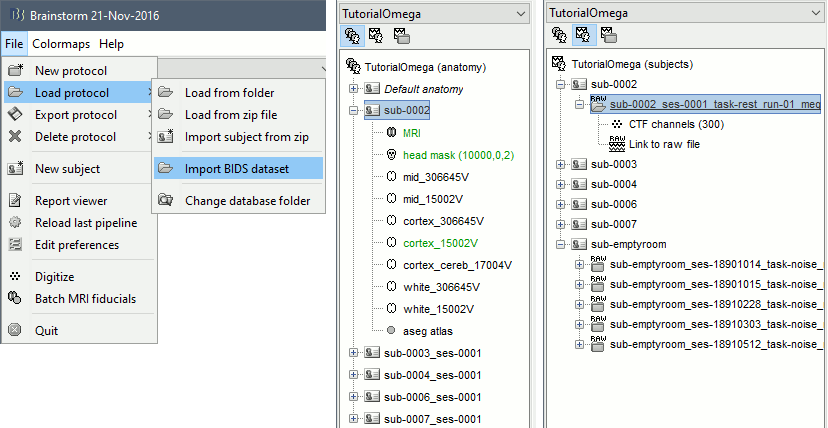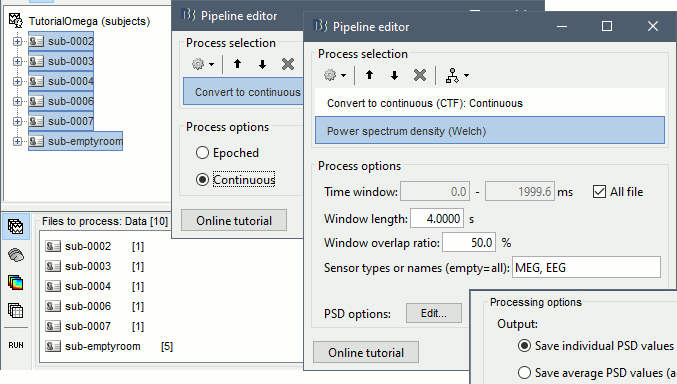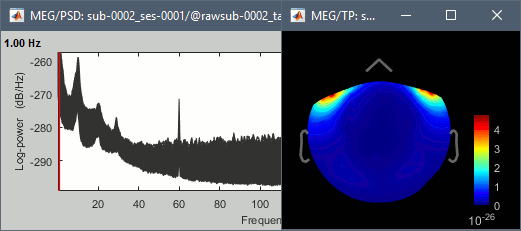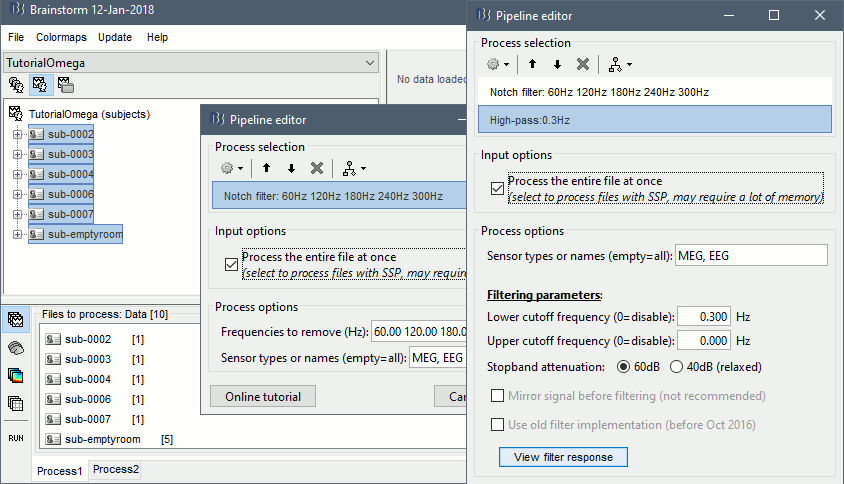|
Size: 5059
Comment:
|
Size: 6599
Comment:
|
| Deletions are marked like this. | Additions are marked like this. |
| Line 2: | Line 2: |
| ''Authors: Francois Tadel, Guiomar Niso, Elizabeth Bock. '' | '''[WARNING: Tutorial under construction, not ready for public use]''' |
| Line 4: | Line 4: |
| This tutorials introduces how to download a resting state recordings from the OMEGA database, and how to process them into Brainstorm. | ''Authors: Francois Tadel, Guiomar Niso, Elizabeth Bock, Sylvain Baillet '' This tutorial introduces how to download resting state recordings from the OMEGA database and process them into Brainstorm. The goal is evaluate where in the brain is distributed the power in specific frequency bands at rest. This example includes only 5 healthy subjects, but the same pipeline can be applied over larger populations. |
| Line 8: | Line 10: |
| == License == | == OMEGA database == |
| Line 17: | Line 19: |
| * 5 subjects * 5 minute resting sessions, eyes open |
* 5 subjects x 5 minute resting sessions, eyes open |
| Line 24: | Line 25: |
| * Recorded channels (340): * 1 Stim channel indicating the presentation times of the audio stimuli: UPPT001 (#1) * 1 Audio signal sent to the subject: UADC001 (#316) * 1 Response channel recordings the finger taps in response to the deviants: UDIO001 (#2) * 26 MEG reference sensors (#5-#30) * 274 MEG axial gradiometers (#31-#304) * 2 EEG electrodes: Cz, Pz (#305 and #306) * 1 ECG bipolar (#307) * 2 EOG bipolar (vertical #308, horizontal #309) * 12 Head tracking channels: Nasion XYZ, Left XYZ, Right XYZ, Error N/L/R (#317-#328) * 20 Unused channels (#3, #4, #310-#315, #329-340) |
* Recorded channels (at least 297): * 26 MEG reference sensors (#2-#27) * 270 MEG axial gradiometers (#28-#297) * 1 ECG bipolar (EEG057/#298) - Not available in the empty room recordings * 1 vertical EOG bipolar (EEG058/#299) - Not available in the empty room recordings * 1 horizontal EOG bipolar (EEG059/#300) - Not available in the empty room recordings |
| Line 38: | Line 34: |
| * 3D digitization using a Polhemus Fastrak device driven by Brainstorm. The .pos files contain: * The position of the center of CTF coils * The position of the anatomical references we use in Brainstorm: Nasion and connections tragus/helix, as illustrated [[http://neuroimage.usc.edu/brainstorm/CoordinateSystems#Pre-auricular_points_.28LPA.2C_RPA.29|here]] * Around 150 head points distributed on the hard parts of the head (no soft tissues) |
3D digitization using a Polhemus Fastrak device driven by Brainstorm. The .pos files contain: * The center of the CTF coils, * The anatomical references we use in Brainstorm: nasion and ears as illustrated [[http://neuroimage.usc.edu/brainstorm/CoordinateSystems#Pre-auricular_points_.28LPA.2C_RPA.29|here]], * Around 150 head points distributed on the hard parts of the head (no soft tissues). |
| Line 44: | Line 41: |
| * Structural T1 image recorded with a 1.5T MRI | * Structural T1 image recorded with a 1.5T MRI (defaced for anonymization purposes) |
| Line 49: | Line 46: |
| * First, make sure you have at least '''20Gb''' of free space on your hard drive (raw files: 12Gb). | * First, make sure you have at least '''40Gb''' of free space on your hard drive (raw files: 12Gb). |
| Line 61: | Line 58: |
| == BIDS specifications == Description of the initiative and its current stage of development. The files that have been imported with this process are the following: * sample_omega/derivatives/freesurfer/sub-000*_ses-0001: MRIs processed with FreeSurfer. * sample_omega/sub-000*/ses-0001/meg/*_task-rest_run-01_meg.ds: Resting MEG recordings * sample_omega/sub-000*/ses-0001/meg/*_task-noise_run-01_meg: Empty room recordings |
|
| Line 62: | Line 68: |
| * The datasets organized following the [[http://bids.neuroimaging.io|BIDS specifications]] can be imported semi-automatically. | * The datasets following the [[http://bids.neuroimaging.io|BIDS specifications]] can be imported automatically in Brainstorm. |
| Line 64: | Line 71: |
| * Keep the default values for all the questions that may be asked during the import process (eg. number of vertices in the cortex surfaces). Once finished, you should be able to see 5 subjects in your database explorer: anatomy, and subject and noise recordings. <<BR>><<BR>> * The files that have been imported with this process are the following: * sample_omega/derivatives/freesurfer/sub-000*_ses-0001: MRIs processed with FreeSurfer. * sample_omega/sub-000*/ses-0001/meg/*_task-rest_run-01_meg.ds: Resting MEG recordings * sample_omega/sub-000*/ses-0001/meg/*_task-noise_run-01_meg: Empty room recordings |
* Keep the default values for all the questions that may be asked during the import process (eg. number of vertices in the cortex surfaces). Once finished, you should be able to access the data for the 5 subjects in your database explorer: anatomy, and subject and noise recordings. <<BR>><<BR>> {{attachment:load_bids.gif||width="594",height="322"}} == Pre-processing == * Switch to the functional view of the protocol (second button above the database explorer). * Drag and drop all the subjects into the Process1 box, and click on [Run]. * Select process: '''Import recordings >''' '''Convert to continuous''': Continuous * Add process: '''Frequency >''' '''Power spectrum density (Welch)''': All file, 4s, 50% overlap, Individual <<BR>><<BR>> {{attachment:psd_process.gif||width="573",height="325"}} * Run, then check the quality of the PSD for all the files, as documented in [[http://neuroimage.usc.edu/brainstorm/Tutorials/ArtifactsFilter#Interpretation_of_the_PSD|this tutorial]]. <<BR>><<BR>> {{attachment:psd_before.gif||width="343",height="152"}} * In Process1, keep the same files selected and click on [Run]. * Select process: '''Pre-process >''' '''Notch filter''': 60 120 180 240 300 Hz, MEG * Add process: '''Pre-process >''' '''Band-pass filter''': High-pass filter at 0.3Hz, 60dB attenuation, MEG * Add process: '''Frequency >''' '''Power spectrum density (Welch)''': Same options <<BR>><<BR>> {{attachment:filter_process.gif||width="597",height="342"}} * Run, then check the PSD after filtering. <<BR>><<BR>> == Resting state metrics == Discuss what measures can be used in resting state MEG... => Ask sylvain to review |
Resting state recordings from the OMEGA database
[WARNING: Tutorial under construction, not ready for public use]
Authors: Francois Tadel, Guiomar Niso, Elizabeth Bock, Sylvain Baillet
This tutorial introduces how to download resting state recordings from the OMEGA database and process them into Brainstorm. The goal is evaluate where in the brain is distributed the power in specific frequency bands at rest. This example includes only 5 healthy subjects, but the same pipeline can be applied over larger populations.
Contents
OMEGA database
The Open MEG Archive (OMEGA) is the fruit of a collaborative effort by the McConnell Brain Imaging Centre and the Université de Montréal to build a centralised repository in which to regroup MEG data for open dissemination. This continuously expanding repository also contains anatomical MRI volumes, demographic and questionnaire information, and eventually will feature other forms of electrophysiological data (e.g. EEG, field, and cell recordings). OMEGA features the technological framework for multi-centric data aggregation, and is amongst the largest freely available resting-state MEG datasets presently available.
You are free to use all data in OMEGA for research purposes; however, we ask that you please cite the following reference in your publications if you have used data from OMEGA:
Niso G, Rogers C, Moreau JT, Chen LY, Madjar C, Das S, Bock E, Tadel F, Evans A, Jolicoeur P, Baillet S
OMEGA: The Open MEG Archive, Neuroimage, 2015.
Presentation of the experiment
Experiment
- 5 subjects x 5 minute resting sessions, eyes open
MEG acquisition
Acquisition at 2400Hz, with a CTF 275 MEG system,
- Recorded at the Montreal Neurological Institute in 2015-2016.
- Anti-aliasing low-pass filter at 600Hz, files saved with the CTF 3rd order gradient compensation.
- Recorded channels (at least 297):
- 26 MEG reference sensors (#2-#27)
- 270 MEG axial gradiometers (#28-#297)
- 1 ECG bipolar (EEG057/#298) - Not available in the empty room recordings
- 1 vertical EOG bipolar (EEG058/#299) - Not available in the empty room recordings
- 1 horizontal EOG bipolar (EEG059/#300) - Not available in the empty room recordings
The data in this dataset has been formatted along the BIDS specifications (Brain Imaging Data Structure, http://bids.neuroimaging.io)
Head shape and fiducial points
3D digitization using a Polhemus Fastrak device driven by Brainstorm. The .pos files contain:
- The center of the CTF coils,
The anatomical references we use in Brainstorm: nasion and ears as illustrated here,
- Around 150 head points distributed on the hard parts of the head (no soft tissues).
Subject anatomy
- Structural T1 image recorded with a 1.5T MRI (defaced for anonymization purposes)
Processed with FreeSurfer 5.3
- The anatomical fiducials (NAS, LPA, RPA) have already been marked and saved in the files fiducials.m
Download and installation
First, make sure you have at least 40Gb of free space on your hard drive (raw files: 12Gb).
- The OMEGA database is not in it its final release stage, so we temporarily distribute the 5 subjects used in this tutorial from the Brainstorm website.
Go to the Download page, and download the file: sample_omega.zip
- Unzip it in a folder that is not in any of the Brainstorm folders (program folder or database folder).
Start Brainstorm (Matlab scripts or stand-alone version). For help, see the Installation page.
Select the menu File > Create new protocol. Name it "TutorialOmega" and select the options:
"No, use individual anatomy",
"No, use one channel file per condition".
BIDS specifications
Description of the initiative and its current stage of development.
The files that have been imported with this process are the following:
sample_omega/derivatives/freesurfer/sub-000*_ses-0001: MRIs processed with FreeSurfer.
- sample_omega/sub-000*/ses-0001/meg/*_task-rest_run-01_meg.ds: Resting MEG recordings
- sample_omega/sub-000*/ses-0001/meg/*_task-noise_run-01_meg: Empty room recordings
Import the dataset
The datasets following the BIDS specifications can be imported automatically in Brainstorm.
Select the menu File > Load protocol > Import BIDS dataset > Select the folder sample_omega.
Keep the default values for all the questions that may be asked during the import process (eg. number of vertices in the cortex surfaces). Once finished, you should be able to access the data for the 5 subjects in your database explorer: anatomy, and subject and noise recordings.

Pre-processing
- Switch to the functional view of the protocol (second button above the database explorer).
- Drag and drop all the subjects into the Process1 box, and click on [Run].
Select process: Import recordings > Convert to continuous: Continuous
Add process: Frequency > Power spectrum density (Welch): All file, 4s, 50% overlap, Individual

Run, then check the quality of the PSD for all the files, as documented in this tutorial.

- In Process1, keep the same files selected and click on [Run].
Select process: Pre-process > Notch filter: 60 120 180 240 300 Hz, MEG
Add process: Pre-process > Band-pass filter: High-pass filter at 0.3Hz, 60dB attenuation, MEG
Add process: Frequency > Power spectrum density (Welch): Same options

Run, then check the PSD after filtering.
Resting state metrics
Discuss what measures can be used in resting state MEG...
=> Ask sylvain to review
